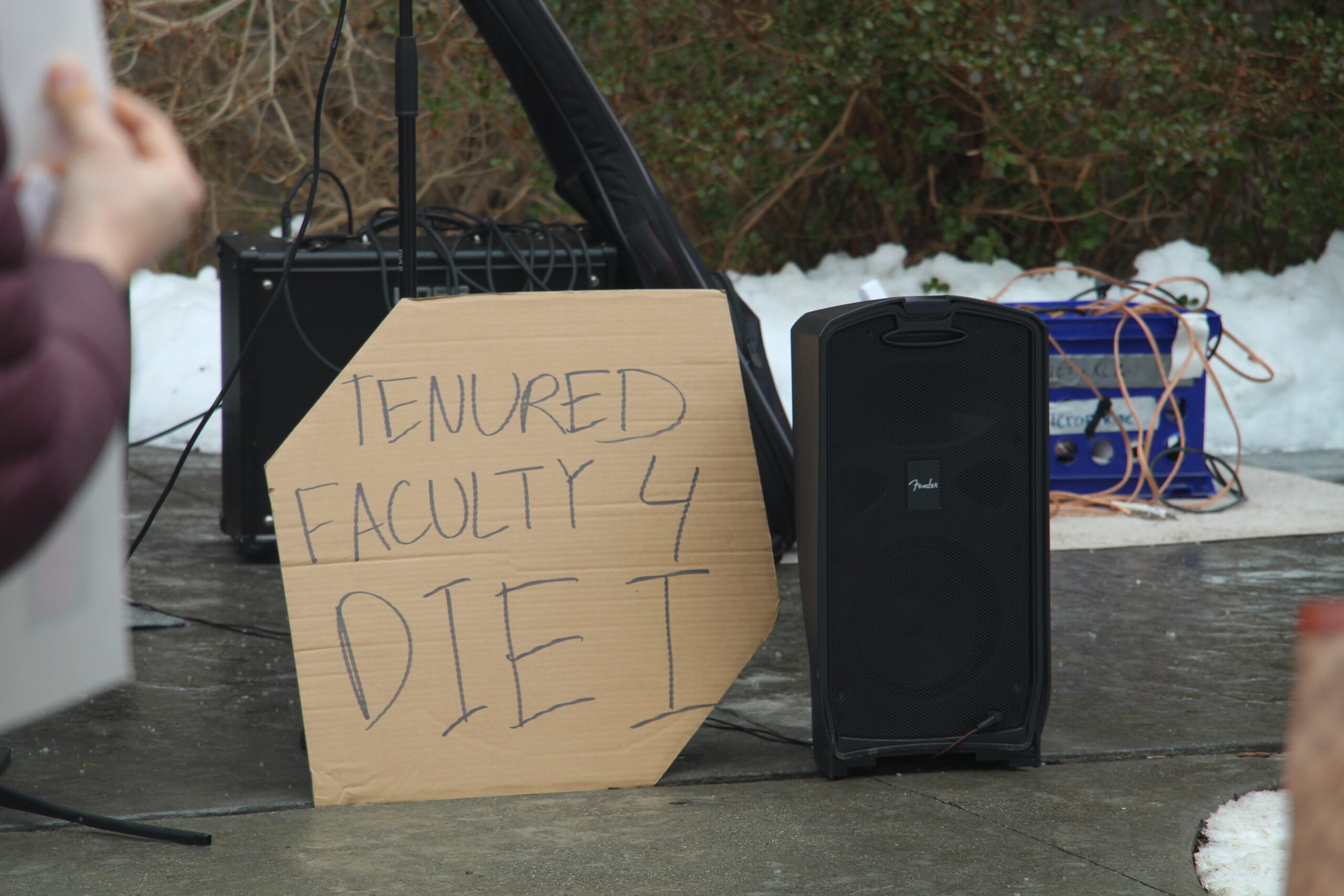Connecticut College is fortunate to be located between Boston and New York City, home to many of the greatest museums in the country. However, students looking for an enriching weekend activity shouldn’t feel the need to immediately purchase a train or bus ticket, when our very own New London is home to the Lyman Allyn Art Museum. In fact, students at Conn don’t even need a car to get to the Lyman Allyn; the museum is located just past the south campus parking lot. This close proximity, along with the historical ties between the College and the Lyman Allyn, provide numerous opportunities for collaboration. One current result of this relationship is the exhibit “Pop Goes the Easel: Pop Art & Its Progeny.”
Pop Art is an art movement that originated in the 1950s and 1960s and is perhaps best known for its use of images from mass media and culture. Often bright and highly stylized, Pop Art is often similar in style to what may be found in comic books and graphic novels, and tends to employ irony and parody in its underlying themes. In the introduction to the exhibit, Connecticut College Art History Professor Barbara Zabel, who is also the exhibit’s curator, explained that, “In the booming post-WWII economy, the commercial world – Detroit, Madison Avenue, Hollywood – exerted unprecedented influence over Americans’ lives, exhorting them to buy the latest model of car, rock & roll record and packaged foods. It is in this milieu that Pop emerged.” While one might think that Andy Warhol created his famous Campbell Soup Can prints for the aesthetic look of them, in reality, there were many more underlying themes that Warhol and his fellow Pop artists were hoping to get across.
The set-up of the exhibit is one of its strongest points, especially knowing that Professor Zabel, along with Lyman Allyn Junior Trustee Devon Elovitz ’13, was particularly interested in highlighting female Pop artists. Andy Warhol and Roy Lichtenstein are incredibly well-known names, but have you ever heard of Idelle Weber and Majorie Strider? Elovitz explained that showcasing their works along with works from male Pop artists was one of her biggest goals, and that “there are two rooms focused on them: ‘Mad Men and Wiley Women.’” Professor Zabel echoed that statement, also explaining that besides gender, differences in “class, region and even visual styles of producing Pop Art” are present in the exhibit. When the viewer turns into the exhibit, two prints immediately recognizable as Warhol’s can be seen in the end of the far gallery. Before the viewer reaches the end, however, he must first enter the two rooms mentioned by Elovitz. In this way, the exhibit almost forces the viewers to broaden their horizons on Pop artists before they are able to see the more typical and expected works.
Immediately upon entering the first gallery, one can make comparisons between Idelle Weber’s work and the intro to the popular TV show Mad Men, but as most of her work was created in the ’60s and ’70s, it’s clear which came first. Weber seemed to be fascinated by men at work, and many of her pieces depict them poring over their work or taking cigarette breaks – women (most often secretaries) are rarely featured. Even though her work features few female office workers, the art itself is created from the point of view of a woman, and how, perhaps, a woman might view her working husband.
Another interesting aspect of the exhibit is the inclusion of three-dimensional objects, as opposed to solely wall-hung pieces. Along with prints and paintings, Weber created a series of pieces using lacquer on Plexiglas, showing, once again, men in the working environment. One of these, entitled “Dewey Ballantine” (1965), shows a man lighting a cigarette over a red and black checkerboard pattern. These pieces feel much more tangible than many of her prints as they can obviously be viewed from all sides, and can help the viewer better understand the many different forms Pop Art can assume.
Along with Weber’s lacquer pieces, artists such as Arman have their own 3-D pieces shown. Arman’s piece “Untitled” (1969) is similar in size to Weber’s pieces, but instead of being painted on, Arman inserted small paint tubes that spill out their contents into the squares. Professor Karen Gonzalez Rice, who is currently teaching a class at Conn on Pop Art, explained that this piece is her favorite from the exhibit. “Arman was a French artist interested in garbage,” she said. “So while Warhol was painstakingly painting Campbell’s soup cans, Arman was dumping actual, used tin cans into vitrines and exhibiting them in galleries. Whereas Warhol was concerned about appearances and branding, Arman was exploring the waste produced by consumer societies.” Professor Gonzalez Rice’s interpretation matches perfectly with what Arman considered himself to be doing; on the sign next to the piece Arman was quoted as explaining his interest in “the pseudo-biological cycle of production, consumption and destruction.”
Besides Weber, the other female Pop artist heavily featured is Marjorie Strider. While Weber’s pieces focus mainly on how women view men, Strider’s pieces are only of women. One example of this, “Sketch for Green Triptych” (1963), highlights Strider’s early sketches for one of her later pieces. The work depicts a woman posing in a bright green bikini. Strider’s work is best known for pushing the female body into the viewer’s face, sometimes doing so by literally attaching protruding wood to the canvas. Because Strider’s work purposefully objectifies the female body, she forces the viewer to consider the sexist ways in which women are portrayed in the media.
The final room in the exhibit features many pieces one commonly associates with Pop Art: a number of Warhols and Lichtensteins, among others. But did you ever consider the now-famous red, white and blue portrait of Barack Obama as a piece of Pop Art? Shepard Fairey’s piece “Change” (2008) was featured in the exhibit, making the connection that can be seen in many other Pop Art pieces between art and politics. Two pieces, “Untitled” and “Untitled B” (both from 2008) by the Chinese Luo Brothers show a number of different Chinese leaders surrounded by Western pop culture items (soda cans and bottles of Heineken, for example) with the labels translated into Chinese characters. Pieces like these further the idea that Pop Art can do more than depict brightly colored images, and often has deeper social meanings.
“Pop Goes the Easel” is a must-see for anyone interested in feminism and art, as well as anyone with a spare hour who might be looking for an exciting and different way to pass time. Because the Lyman Allyn is so close to Conn, a visit doesn’t have to be planned far in advance. The exhibit doesn’t take long to view, and entrance to the Lyman Allyn Art Museum is free to all Connecticut College students with their school ID. The exhibit will run until August 10, 2013, and will hopefully lead to even more collaboration between the College and the museum.










Have you ever wondered how you could help those who are less fortunate than you?
“But did you ever consider the now-famous red, white and blue portrait of Barack Obama as a piece of Pop Art? Shepard Fairey’s piece “Change” (2008) was featured in the exhibit…”
It’s so awesome when you see students considering the spectrum of art and talking about the living nature of art. Pop Art is a movement that continues and thrives today.
[…] On-Campus Pop Art Exhibition Goes Beyond Warhol – Along with Weber’s lacquer pieces, artists such as Arman have their own 3-D pieces shown … and often has deeper social meanings. “Pop Goes the Easel” is a must-see for anyone interested in feminism and art, as well as anyone with a spare hour … […]